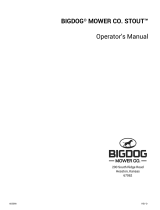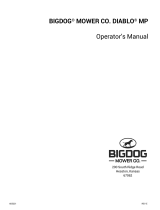
19
a. Attach the end of the red jumper cable to the Pos-
itive terminal (+) of the charged battery.
b. Attach the other end of the red jumper cable to
the Positive terminal (+) of the low charge bat-
tery.
c. Attach the end of the black jumper cable to the
Negative terminal of the charged battery.
d. Attach the other end of the black jumper cable to
the frame of the unit with the low charge battery.
6.
Fuses:
There is one fuse located in the wiring
between the ignition and start switch and other elec-
trical components. This is a standard plug-in type
automotive fuse rated at 20 amp.
7.
Safety Switches:
There are three safety switches in
the electrical circuit which control the engine. They
are (1) the blade clutch switch, (2) the parking brake
switch, and (3) the seat switch.They operate so that
in order to start the engine, the blade clutch switch
must be off, the parking brake must be engaged, and
the speed control pedals must be in the neutral posi-
tion. Once the engine is started, the seat must be
occupied and the parking brake must be released
before the speed control pedals can be moved. Also,
the seat must be occupied before the blade clutch
switch can cause the blades to rotate.
8.
Safety Switch Operation Checks:
The following
operational checks should be made daily.
a. Blade Clutch Switch: Sit in the operator’s seat.
With the speed control pedals in the neutral posi-
tion and the parking brake engaged, turn the
blade clutch switch “on” and try to start the
engine. The engine should not start. If it does, the
blade clutch switch must be replaced. If the
engine does not start, turn the blade clutch switch
“off” and start the engine. Now turn the blade
clutch switch “on” and the blades should rotate.
If the blades do not turn, the blade clutch switch
must be replaced, the seat switch must be
replaced or the electric PTO clutch must be
repaired.
The air-gap should be checked every 100 hrs. (or
less, if severe operating conditions exist such as
when there are many on/off cycles, mulching
operations, material collection systems used, and
dusty/dirty conditions), and the air-gap adjusted
if more than 0.025". To inspect, remove the “neg-
ative” cable from the battery and all sparkplug
wires. The air-gap should be checked with feeler
gages in the three slots of the BBC (PTO Clutch).
See page 23 for air gap adjustment specs. There
are three inspection slots in the brake cover. To
adjust, successively tighten each of the three gap
adjustment nuts an equal amount. Insert a feeler
gage (see page 23 for specs) into each slot as the
air gap adjustment nut are tightened. The correct
adjustment occurs when slight contact with the
feeler gage occurs. Engage the BBC (PTO
Clutch) a couple of times, and re-check the air-
gap. If it is not between the specs listed on page
23, repeat the adjustment procedure.
b. Parking Brake Switch: Sit in the operator’s
seat. With the speed control pedals in the neutral
position and the blade clutch switch “off”, release
the parking brake and try to start the engine. The
engine should not start. If it does, the parking
brake switch must be repositioned or perhaps
replaced. If the engine does not start, engage the
parking brake and start the engine.
c. Seat Switch: With the speed control pedals in the
neutral position, the parking brake engaged and
the blade clutch switch in the “off” position, start
the engine. Now, while sitting in the seat, release
the parking brake, then, raise up slightly off the
operator’s seat and the engine should stop. If the
engine does not stop, the seat switch must be
replaced. With the speed control pedals in the
neutral position, the parking brake engaged and
the blade clutch switch in the “off” position, sit in
the operator’s seat and start the engine. Turn the
blade clutch switch to the “on” position and the
blades should start to rotate. Raise up slightly off
the operator’s seat and the blades should stop. If
the blades do not stop when you dismount from
the operator’s seat, the seat switch must be
replaced.
d. Electric PTO Clutch: This clutch operates when
the engine is running, the operator is in the opera-
tor’s seat and the blade clutch switch is turned
on.This electric clutch is a fairly trouble free
device. If a problem develops and the blades do
not turn, first check the 20 amp fuse in the yel-
low, 16-gauge wire between terminal “L” (for the
Gasoline Engine) on the ignition switch and the
hour meter and then investigate the wiring har-
ness and the connections to the seat switch, the
blade clutch switch and the electric blade clutch.
Then check out the seat switch, the blade clutch
switch and finally the electric blade clutch.
D.Tires
The two front wheels are steerable wheels that are
synchronized to turn in coordination with the speed and
direction of the rear wheel motors.
The two rear wheels are used to propel the Mower in the
direction of input from the speed control pedals. Inflation
pressure of the front and rear tires is important for traction
and stability while the Mower is in operation. If the tire
diameters are not equal between the tires, the Mower will pull
to one side.
1.
Inflation Pressure:
a. Traction Tires—20 psi max; 10-12 psi recom-
mended























